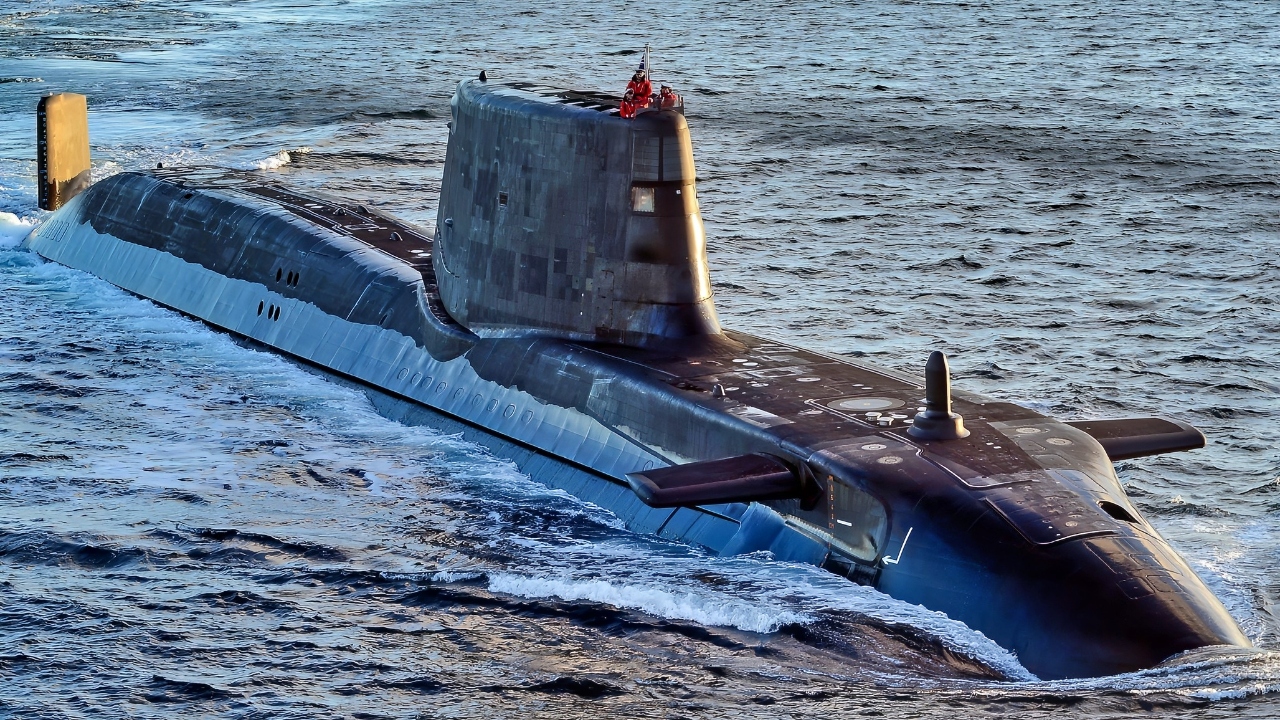Article Summary – A new generation of nuclear attack submarines is transforming undersea warfare.
-This piece profiles the five standout designs: America’s Virginia-class with its missile-packed Virginia Payload Module, Russia’s Yasen-M with Kalibr, Oniks, and Zircon hypersonics, France’s cruise-missile-armed Barracuda, Britain’s ultra-quiet Astute class, and the US Seawolf, still arguably the most capable SSN ever built.

Astute-Class. Image Credit: Creative Commons.
-Each brings extreme stealth, advanced sonar, and long-range strike options that make them central to deterrence, sea control, and special operations.
-An honorable mention goes to China’s emerging Type 095 “Tang” class, highlighting how crowded and competitive the deep is becoming.
What Are The Five Best Attack Submarines In the World?
In the global landscape over the past few years, we have witnessed a rapid acceleration in undersea warfare capabilities as major powers invest heavily in the next generation of attack submarines.
From nuclear-powered boats with hypersonic strike capacity to ultra-quiet diesel-electric boats armed with ballistic missiles, these outstanding attack boats now serve as critical assets for strategic deterrence, sea control, intelligence gathering, and special operations.
Driven by various motives, including expanding empires, regional tensions, evolving naval doctrines, and industrial self-reliance, countries across Europe, Asia, and the Americas have launched highly advanced attack submarine programs that are redefining the balance of power under the sea.
The five best attack submarines are the Virginia-class Block VI (U.S.), Yasen-M class (Russia), Barracuda-class (France), Astute class (UK), and Seawolf class (US), all noted for their advanced stealth, sonar, and armament capabilities. The Virginia and Seawolf classes represent the pinnacle of US technology. At the same time, the Yasen-M is Russia’s most advanced design, the Barracuda is France’s modern attack submarine, and the Astute class is renowned for its stealth and low noise signature.
Here’s a detailed look at the best attack submarines.
Virginia-class Block VI (United States)
The US Navy’s Virginia-class Block VI submarines represent a significant upgrade to the fleet, incorporating advancements in stealth, sonar, and payload capacity.
These submarines are designed to support anti-submarine warfare, surface ship warfare, special operations, and land-attack missions. The Block VI introduces the Virginia Payload Module (VPM), which enhances Tomahawk missile capacity and flexibility.
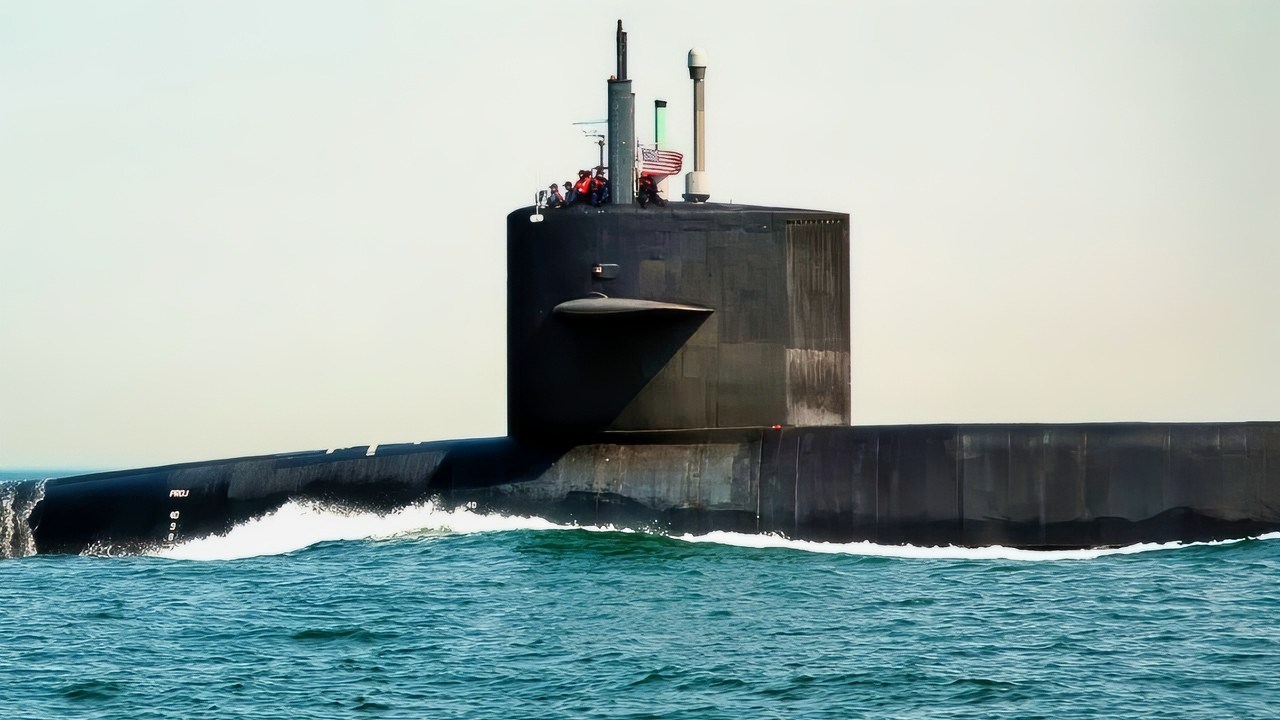
(March 31, 2006) – The guided missile submarine USS Florida (SSGN 728) conducts sea trials off the coast of Virginia. Florida will be delivered to the Fleet in April, and a Return To Service ceremony is scheduled for May 25 in Mayport, Fla. As the second of four SSBN submarines to be converted to SSGN, this nuclear-powered submarine will have the capability to: launch up to 154 Tomahawk cruise missiles; conduct sustained special warfare operations with up to 102 Special Operations Forces (SOF) personnel for short durations or 66 SOF personnel for sustained operations; and provide approximately 70 percent operational availability forward deployed in support of combatant mission requirements. U.S. Navy photo by Chief Journalist (SW/AW) Dave Fliesen.

Virginia-Class Submarine Cut Out. Image Credit: Creative Commons.
General Dynamics Electric Boat (GDEB) has secured a contract modification worth $1.06 billion to procure long-lead-time materials for the construction of Virginia-class Block VI submarines.
GDEB is the prime contractor and lead design yard for the Virginia-class. It builds the vessels in a teaming arrangement with HII’s Newport News Shipbuilding. The Navy currently has 24 Virginia-class boats in service, with another 16 either awaiting delivery or under construction.
Virginia Payload Module
The Block VIs will be the second set of Virginia-class attack submarines to feature the Virginia Payload Module (VPM), which will meet the Navy’s requirement for a large-scale land strike missile platform after the service decommissions four Ohio-class guided-missile submarines by the end of the decade.
In the last several years, the Ohio guided-missile boats, each capable of fielding 154 Tomahawk Land Attack Missiles, have been a favorite of combatant commanders.
USS Florida (SSGN-728) was deployed for almost two years to defend against threats in the Mediterranean and the Middle East, returning last August.
The VPM inserts four Multiple All-up-round Canisters (MAC) in the middle of the submarine in addition to two in the bow. Each MAC tube can contain seven Tomahawk cruise missiles. The Navy has stated that it will need 20 VPM boats to replace the strike missiles lost when the Ohio-class submarines retire.
The module is 84 feet long—bringing the total length of the Virginia-class subs up from 377 feet to 461 feet, the Navy file said—and can store and launch payloads with diameters larger than the 21-inch diameter of a torpedo or Tomahawk missile. This will increase the Virginia-class boats’ Tomahawk missile capacity from 12 to 40.
The US Navy is using strong fiber optic cable to connect undersea submarines to drones able to travel to the surface and interface with surface gateway technologies in a position to essentially translate acoustic data gathered by submarines beneath the surface into RF signals and other kinds of data links able to share information with air, surface, and land communications nodes.
Among the new technologies is the Navy’s hypersonic weapons. The Navy intends to arm its submarines with the Conventional Prompt Strike weapon before 2028. The arrival of undersea-launched hypersonics will ensure the Navy has a high-speed attack advantage.
And once the long-awaited Columbia-class missile boats finally come online, the Virginia Block VI boats will give the US Navy continued superiority over near-peer threats against China and Russia.
Yasen-M class (Russia)
The Russian Navy’s latest nuclear-powered attack submarine, the Perm, a fourth-generation Yasen-M-class submarine, was launched by Russian President Putin on March 27, 2025.
The Yasen-M class (Project 885M) is a modernized version of the Yasen-class submarines, developed by the Malakhit Marine Engineering Bureau under the guidance of Chief Designer Vladimir Pyalov.
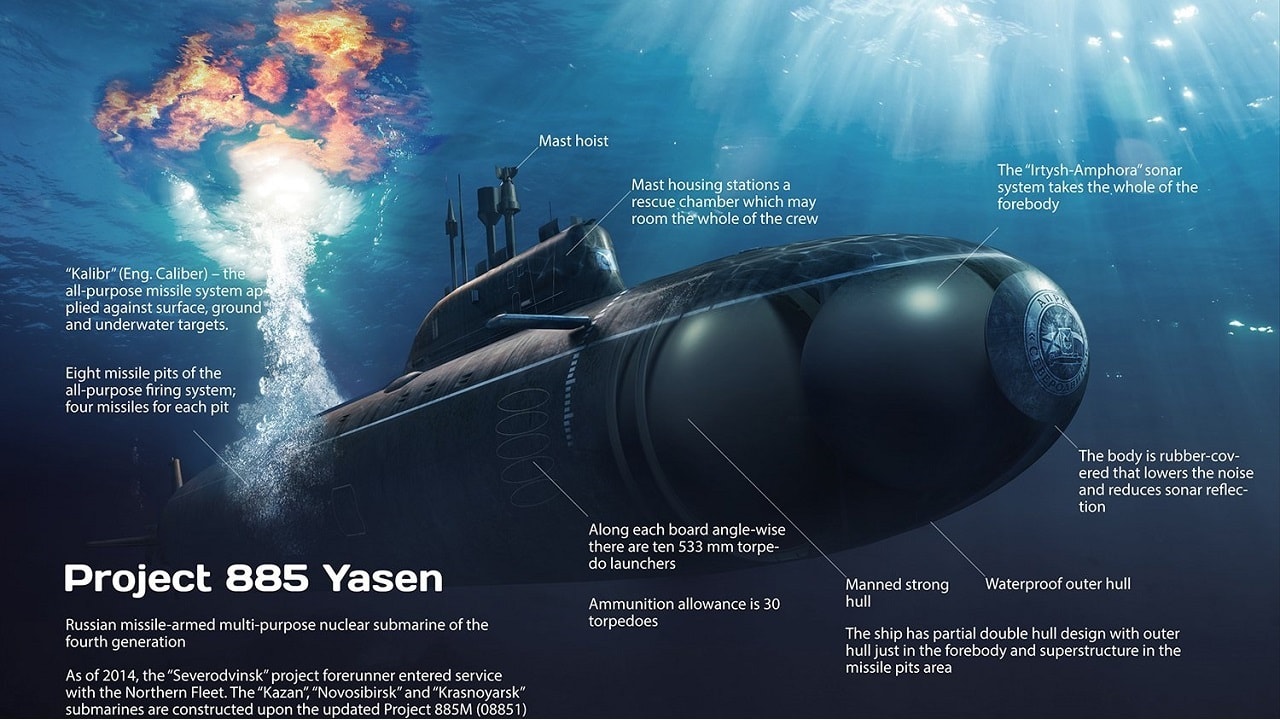
Yasen-Class submarine. Image Credit: Russian Government.
Yasen-M Class Propulsion System
The Perm is powered by an updated KTP-6-185SP pressurized water-cooled nuclear reactor, generating approximately 200 megawatts (equivalent to approximately 268,204 hp).
Propulsion is provided through a single shaft and low-noise propeller, supported by two thrusters, allowing the submarine to reach speeds of up to 31 knots underwater and 16 knots on the surface.
This fourth-generation nuclear reactor has a 25–30-year core life, eliminating the need for mid-life refueling, and allows for natural coolant circulation, contributing to lower acoustic signatures on par with the latest Western SSNs.
The Perm’s overall length is 130 meters, with a beam of 13 meters and a draft of 9.4 meters, and it accommodates a crew of 64 officers and crew.
With a maximum diving depth of 600 meters and an operational depth of 520 meters, the Perm can remain submerged for up to 100 days. The vessel has a submerged displacement of 13,800 tons and a surface displacement of 8,600 tons, slightly less than those of earlier Yasen-M units.
Yasen-M Class Armaments
The Yasen-M Class is a potent platform. It has a more extended strike capability than Western submarines. The weapons carried by these submarines represent a significant shift in their mission, from the hunter-killer role to the launch of a full range of anti-ship and land-attack missiles.
These missiles include the advanced Kalibr and Oniks cruise missiles, as well as the hypersonic Zircon missiles. These weapons, along with their torpedo armament, allow the submarine to conduct anti-submarine, anti-ship, and land-attack missions.
The Zircon hypersonic cruise missile (also known as Tsirkon or SS-N-33) is a Russian hypersonic cruise missile with a scramjet engine and nuclear capability. It’s designed for deployment from surface vessels, submarines, and aircraft.
The Zircon reportedly has a top speed of Mach 9 and a range of up to 1,000 kilometers, according to Putin’s 2019 State of the Nation address. However, many Western experts at the time believed that Zircon’s firing range would fall somewhere between 400 and 500 km [215-270 nm], and its top speed would be limited to between Mach 5 and 6—still a potent weapon.
The Yasen-M’s armament includes 10 torpedo tubes of 533 mm caliber, located in the midsection of the hull and mounted at an angle due to the presence of a large spherical sonar array in the bow.
Barracuda-class (France)
The Barracuda program began in the early 2000s to replace France’s Rubis-class SSNs. The first submarine, Suffren, was commissioned in 2022, followed by Duguay-Trouin in 2023. Four additional units are under construction, with complete fleet delivery planned before 2030.
The Barracuda class displaces around 5,300 tons submerged and is powered by the K15 pressurized-water reactor adapted from France’s strategic submarine fleet.
It incorporates pump-jet propulsion, advanced automation, and a crew-reducing digital architecture. Armament includes MdCN cruise missiles (1,000+ km range), Exocet SM39 anti-ship missiles, and F21 torpedoes. The Thales S-CUBE sonar suite and SYCOBS combat system provide high-fidelity threat detection and weapon control.
The Barracuda is the only European SSN equipped with strategic-range cruise missiles, pump-jet propulsion, and full-spectrum special operations capability, tailored for NATO and Indo-Pacific expeditionary roles.
Astute-class (United Kingdom)
The Royal Navy has an outstanding platform in attack submarines. Britain’s Astute-class submarines are the UK’s version of the US Virginia-class, and are exceptional in stealth, speed, and lethality.
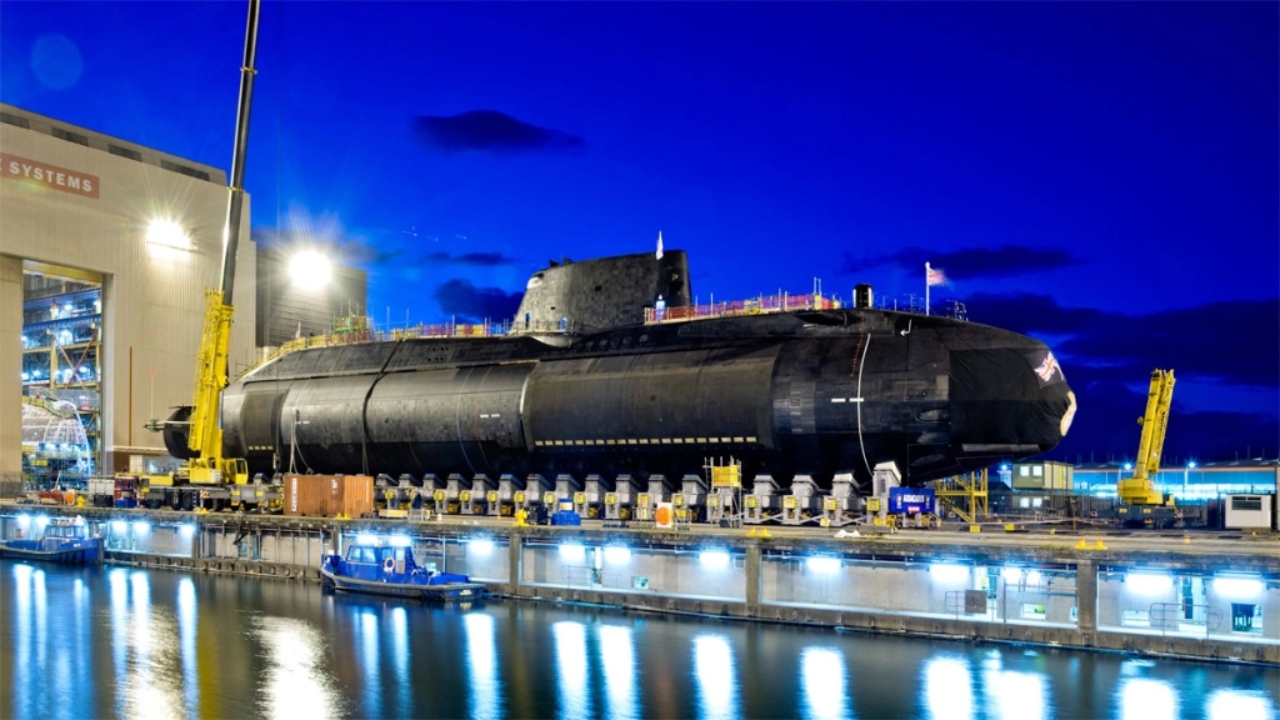
Astute-Class Submarine. Image Credit: Creative Commons/BAE Systems.
Built by BAE Systems and equipped with powerful Rolls-Royce nuclear reactors that require minimal maintenance, they move silently at up to 30 knots.
Astute boats deploy Spearfish heavyweight torpedoes and Tomahawk missiles, enabling precise, long-range strikes. Advanced electronic warfare suites and sonar systems provide excellent survivability, while quieting technology makes them nearly undetectable.
A great feature of the Astute-class subs is that, like their American counterparts, they can deploy small Special Operations Forces scuba teams from the Special Boat Service or SAS, using their stealth to sneak in close to an enemy shore to take out designated high-value targets.
Different Than Virginia-class Boats But Extremely Capable
The Astute Class is different than the US Virginia class. They are smaller, but that was by design. The British designed them to be stealthy and fast.
The armament carried by the Astute boats is impressive. There are six torpedo tubes for launching 38 Spearfish heavyweight torpedoes. Spearfish torpedoes have an 18-mile range and are deadly accurate with a powerful warhead.
The Tomahawk Block IV and the updated Block V land-attack cruise missiles have a range of about 1,000 miles. This is the main armament of the Astute-class, and they can make the enemy pay the price from long range. The Tomahawks are a good choice when the British do not want to deploy troops or military hardware to a warzone.
A dry deck structure is used to infiltrate or exfiltrate Special Boat Service special operators. And the 39,000 anechoic tiles keep the Astute boats “as quiet as a baby dolphin.”
Seawolf-class (United States)
The ships were also designed to carry a significant arsenal of weapons, including more Tomahawk cruise missiles, and were equipped for both blue-water and shallow-water operations. The Seawolf could race at 35 knots beneath the surface or go 20 knots in silent mode.
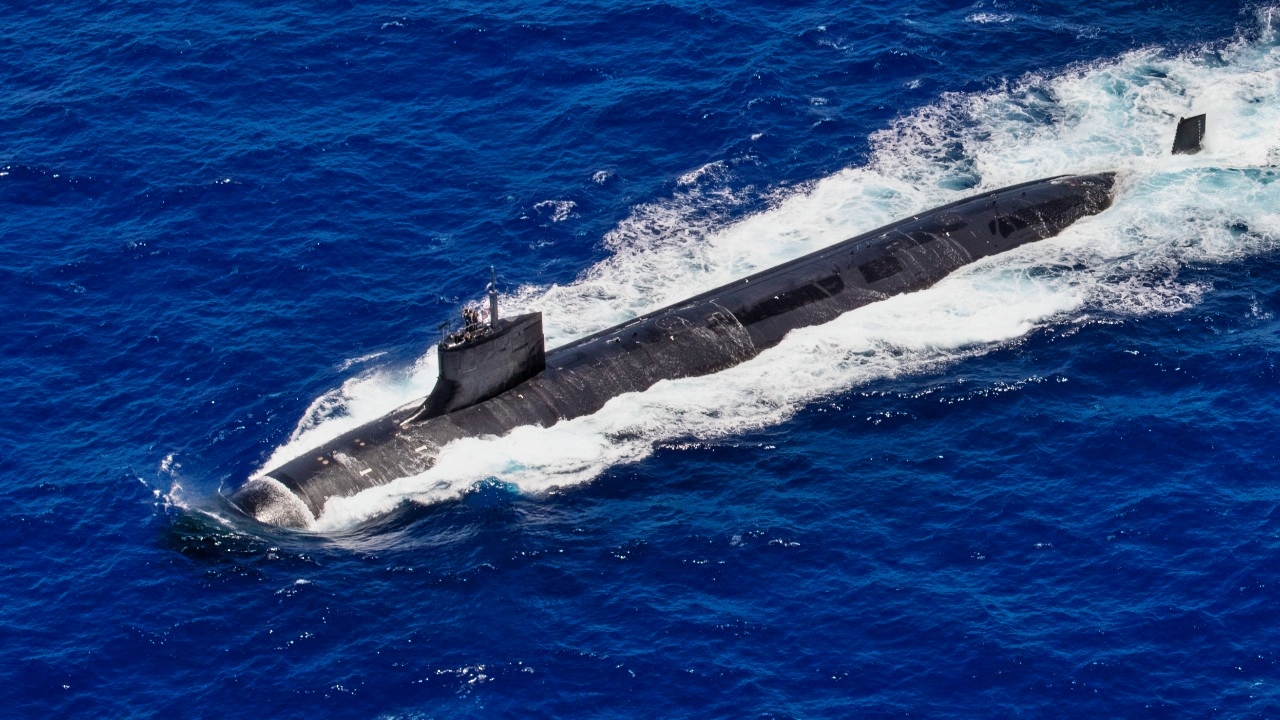
(June 22, 2021) Seawolf-class fast attack submarine USS Seawolf (SSN 21) transits the Pacific Ocean, June 22, 2021. Seawolf is currently underway conducting routine maritime operations in U.S. 3rd Fleet. (U.S. Navy photo by Mass Communication Specialist 3rd Class Olympia O. McCoy)
The Seawolf-Class Sub Is More Advanced Than The Virginia Boats
The Seawolf nuclear attack submarine was the cat’s a … er meow. The Navy wanted the very best, and they sure got every penny’s worth. The Navy and the designers stuffed every crevice with the very best technology that money could buy. And the price tag showed it.
However, the submarine was in a class all by itself. The hull was designed to withstand deeper dives; it weighed 9,000 tons, could carry 50 torpedoes and cruise missiles, and had an unsurpassed level of stealth.
The boat was about 300 yards long, packed with weapons and technology, and quieter than a church mouse. And then the Soviet Union collapsed in on itself. The 29 subs the Navy wanted were reduced to 12, and then to three.
In another short-sighted move, the Pentagon sliced the program to the bone. The Clinton administration’s “peace dividend” was a mistake that the War Department is still paying for today.
The Seawolf attack submarines were designed to carry a significant arsenal of weapons, including more Tomahawk cruise missiles, and were equipped for both blue-water and shallow-water operations. The Seawolf could race at 35 knots beneath the surface or go 20 knots in silent mode.
An Amazing Submarine
The Seawolf nuclear attack submarine was the best in the world by a large margin when it was introduced. The Navy wanted the very best, and they sure got every penny’s worth. The Navy and the designers stuffed every crevice with the very best technology that money could buy. And the price tag showed it.
However, the submarine was in a class all by itself. The hull was designed to withstand deeper dives; it weighed 9,000 tons, could carry 50 torpedoes and cruise missiles, and had an unsurpassed level of stealth.
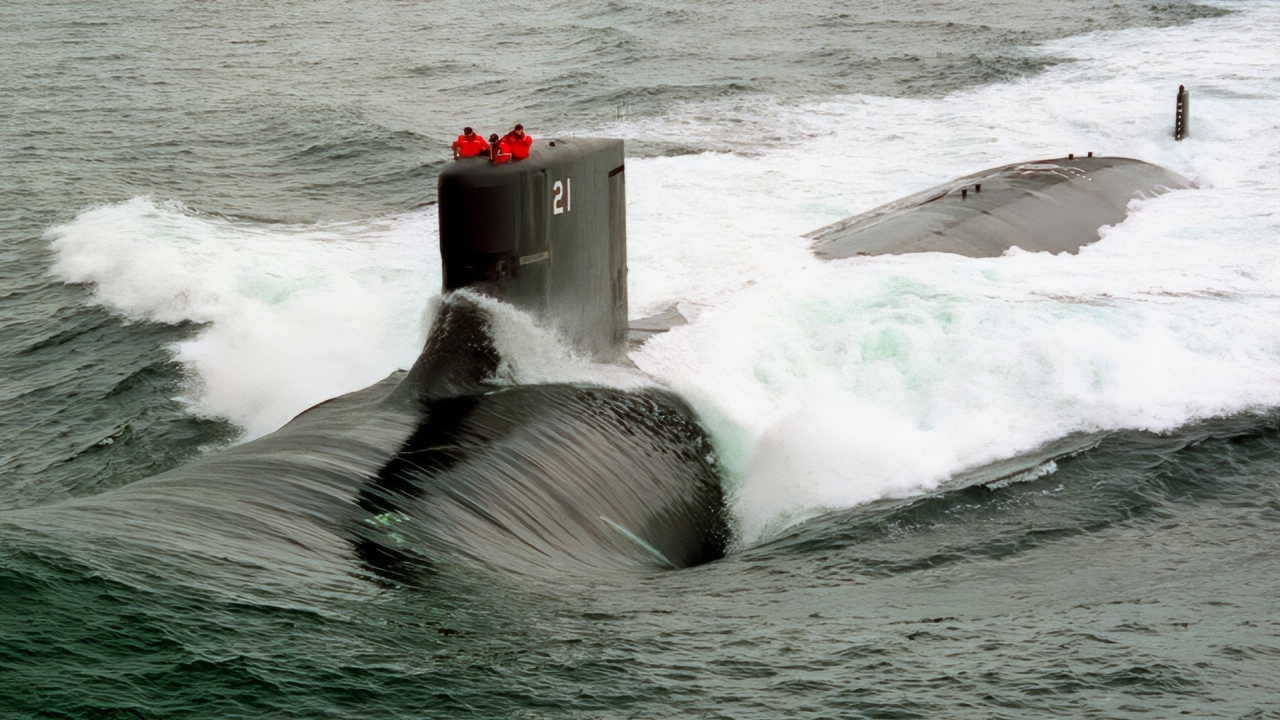
The U.S. Navy attack submarine, USS Seawolf (SSN 21), conducts Bravo sea trials off the coast of Connecticut in preparation for its scheduled commissioning in July 1997. Image Credit: Creative Commons.
The boat was about 300 yards long, packed with weapons and technology, and quieter than a church mouse. And then the Soviet Union collapsed in on itself. The 29 subs the Navy wanted were reduced to 12, and then to three.
In another short-sighted move, the Pentagon sliced the program to the bone. The Clinton administration’s “peace dividend” was a mistake that the War Department is still paying for today.
They are fast, stealthy, chock full of weapons, and able to dive deeper because of a thicker, stronger hull.
The robust design of the Seawolf class enables these submarines to perform a broad spectrum of crucial military assignments – from underneath the Arctic icepack to littoral regions anywhere in the world.
Their missions include surveillance, intelligence collection, special warfare, cruise missile strike, mine warfare, and anti-submarine and anti-surface ship warfare.
Displacement: 9,137 tons submerged (12,139 tons for the Jimmy Carter). Length: 353 feet (453 feet for the Jimmy Carter), Hull Diameter:40 feet, Draft: 35 feet, Diving Depth: 800+ feet, Weapons: 37 Mark 48 anti-submarine torpedoes, 13 Tomahawk cruise missiles
The ship had a complement of 130 officers and enlisted crew members, and General Dynamics claims that its stealth is so good that it is less detectable at high speed than a Los Angeles-class submarine sitting at pier side.
Honorable Mention: Type 095 Tang-Class – (China)
China began the Type 095 program in the early 2010s to replace the Type 093A. At least two hulls were launched between late 2023 and 2025 at Huludao Shipyard. Full operational capability is expected by late 2025 or early 2026.
About the Author:
Steve Balestrieri is a National Security Columnist. He served as a US Army Special Forces NCO and Warrant Officer. In addition to writing on defense, he covers the NFL for PatsFans.com and is a member of the Pro Football Writers of America (PFWA). His work was regularly featured in many military publications.
More Military
Taiwan’s F-16V Fighter Was Built to Fight China’s Air Force
5 Places World War III Could Break Out in 2026
The X-37B Space Plane Is Breaking All the Rules and Makes Chinese Generals Sweat


